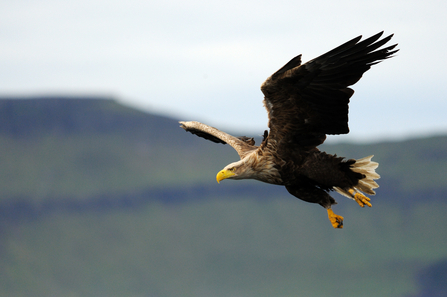On a drive through North Norfolk on a sunny day, you can't miss the red kites. With their long, broad wings, v-shaped tail and leisurely circling, there is no mistaking them. They have a 5-foot wingspan, pale orange to crimson body, a pale grey head and a distinctively forked tail (often it is twisted in flight). These features are all striking if you're looking at a perched bird, and their huge size should be a big giveaway. In flight, you should look out for the dark wings with a distinctive white "flash" near the tip.
But what's the back story behind these soaring scavengers? It’s a turbulent one…
For many years, kites were happily scavenging the streets of London, however, as time progressed the city people became tidier and more organised and the birds didn't have enough to eat. This drove them out into the countryside, where, in the 19th century, they encountered persecution and were poisoned so heavily that they were driven to only one area in mid-Wales. At their lowest point, only five pairs remained. In the next century, conservation measures were put in place, and the Welsh population slowly crawled up. But it would take many years for numbers to increase - they needed a boost.
In 1989, birds from Spain were brought and released into the Chilterns and Northern Scotland. The Chilterns population thrived, and chicks were taken from this locality to others, aiding the spread. However, the Scottish birds were not so successful, and persecution continued. Thus, this population stayed low.
These days, red kites are widespread across Britain (but still uncommon in Scotland), and interestingly, the European population has declined. Also, most kites in mainland Europe are summer migrants only, whereas our birds are resident. Even so, our population is only around 4400 pairs.
In Norfolk, there are many good places to see kites, such as Holkham NNR and Sculthorpe Moor, but a drive through North Norfolk should also yield excellent results. But if you want a really good show, go to Gigrin Farm in mid-Wales. You'll enjoy that, as hundreds of birds fly down to scavenge from meat thrown by the owners. This was one of the last outposts of native kites, and remains one today.
Red kites may be on the increase, but they're still vulnerable, and very much in need of protection. There are still many people, mainly farmers, out there who trap and poison birds of prey to stop them eating their livestock, but red kites are scavengers! The majority of their diet consists of roadkill, and when they do hunt it is only for small rodents. White-tailed eagles fell into much the same disgrace, said to eat lambs and even children but they only catch fish!

White-tailed eagle (credit: Amy Lewis)
I wished for so long to see a white-tailed eagle, and when I saw one flying over Calgary Bay on the Isle of Mull in October 2022, I was ecstatic! They are dark brown all over and adults also show a white tail and buff-washed head. These awesome birds have also made an incredible recovery since their reintroduction in the 1940s. The population of about 150 pairs is based on the Inner Hebrides in West Scotland, and the first pair has bred this year in southern England. However, Norfolk is becoming a hotspot for immigrant juveniles, so keep your eyes peeled for a huge, rectangular bird with a 2-metre wingspan! But the best place to see them is on the Isle of Mull in Scotland, where feeding boat trips are organised. I've not been on one (as when I went we just drove across the island looking up!) but I've heard good things about them. They throw fish off the boat: the eagles come!
So now hopefully you know a little more about how conservation has helped to bring two incredible birds back from the brink - the white-tailed eagle and red kite. A trip to Holkham NNR in winter could give you both these species, so good luck and happy bird-watching!

